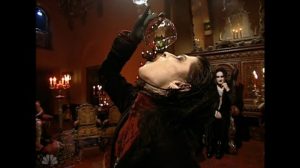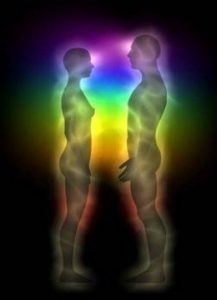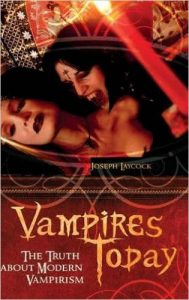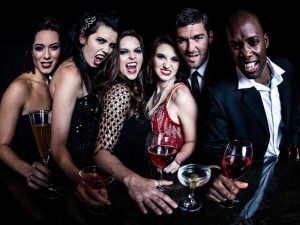Real Vampires That Feed on Energy
Vampires

Main Page
The Vampire Subculture
"They drink blood, they sleep all day in coffins…they say they're real life vampires… and they might just be living next door to you." Tyra Banks' description of a group of people who are part of a deviant subculture is one of many examples of how the media perpetuates moral panics surrounding deviant behavior. The deviant group she describes is the vampire subculture. The vampire subculture or "real vampires" consists of individuals that identify as non-human vampires. These "real vampires" feed on the energy of non-vampires through either the drinking of blood or through psychic means. The people in the vampire community truly believe themselves to have been born vampires, as opposed to humans. Belfazaar Ashantison, a "real vampire" interviewed for the YouTube documentary series, Vampires: New Orleans, states, "if it were a lifestyle choice, I damn sure wouldn't choose drinking blood."
Members of the Vampire Community

Don Henrie, a sanguinarian vampire and self-proclaimed "Vampire King" drinking a glass of blood
Real vampires believe they must feed on the energy of other people in order to "sustain their physical, mental, and spiritual health" (Laycock 2010). This feeding on sources of energy is done in a variety of methods. The "Sanguinarian" (or Sang) vampires ingest small amounts of blood, human or otherwise, in order to obtain the energy that they believe is held within the blood. This blood is obtained through a willing donor. The act of feeding on a donor is known as "bloodletting."When "real vampires" feed upon a donor, they typically utilize safe means so as not to bring harm to the donors. The identities of the real vampires and their respective donors are confidential. Most Sang vampires only require a few drops of blood, however, some drink as much as a glassful of blood.

A visual example of prana/aura. Psychic vampires can see and feed off of the pranic energy of individuals.
The counterpart to the Sanguinarian vampires are the "Psychic" vampires (or Psi). The psychic vampires typically do not believe that it is necessary for them to consume blood in order to obtain the energy they need to survive. Rather, psychic vampires "drain the bodily energy of others by psychic means" (Keyworth 2002). Psychic vampires feed in a number of different ways, the two most common being through touch, in which a psychic vampire can take the energy they need by touching a person, and through what is known as "proximity feeding" (Vampire Underworld 2014). Proximity feeding is, essentially, feeding off of the energy of those in proximity of the vampire. The energy that is taken during proximity feeding is either "pranic" or emotional. Pranic energy is named after the word "prana" (also known as "aura" or "chi") meaning life-force. It is the energy people give off by being alive. Emotional energy is the energy rooted in a person's emotional state. Psychic vampires who ingest blood from time to time are known as "hybrids" (or Psi/Sang). There are also many subsets of these types of vampires.

Lifestyle vampires typically wear fangs as well as black and red gothic clothing.
Lifestyle vampires, as opposed to "real vampires," are individuals who voluntarily participate in the vampire subculture by dressing in a Gothic fashion but do not require feeding on energy to maintain their health (Laycock 2010). Lifestyle vampires are also known as "vampyres" or "lifestylers." Real vampires do not like to be associated with lifestyle vampires; however, they do not reject them entirely. There are many different ways in which "real vampires" live their lives and there are many individuals who are considered to be real vampires that dress in Gothic clothing or sleep in coffins just as lifestyle vampires do. Since real vampires do not believe it is their place to tell someone whether they are indeed a "real vampire" or not, there is often a great deal of intermingling between the real vampires and the lifestyle vampires.

Vampire: the Masqueradevideo game cover
There are also members of the Vampire Community known as "roleplayers." Roleplayers are players of the live-action role play game "Vampire: the Masquerade." Vampire: The Masquerade started out as a tabletop storytelling game, but has since expanded to include video games, books, soundtracks, card games, etc. and has a large fanbase. These members of the Vampire Community are not accepted by "real vampires" as "real vampires" often try to distance themselves from roleplayers. The reason behind this distancing is because roleplayers are often responsible for negative attention towards the Vampire Community, as, in extreme cases, they have blurred the line between reality and fiction. Furthermore, "real vampires" do not want to be trivialized by being viewed simply as people playing a game. Although roleplayers and lifestylers are not considered to be "real vampires," they are recognized as members of the Vampire Community. Essentially, the criteria for authenticity of a "real vampire" is possessing the feeling of being drained of energy which can only be remedied by feeding on the energy of others.
Shared Characteristics of "Real Vampires"

Fangsmith, Ra Ubasti, applying custom-made fangs to a customer.
The real vampires often have many shared characteristics and identities. A unique aspect of the vampire subculture is that the vampire subculture has a lot of overlap with other subcultures. For instance, although the vampire subculture has stemmed from the Gothic movement (Keyworth 2002), and there are a great number of "real vampires" who engage in aspects of Gothic culture, many modern vampires do not identify as being Goth (Laycock 2010). Even so, many "real vampires" have shared interests in music. Gothic Rock, Gothic Metal, and Darkwave music in general are common genres of music favored by the Vampire Community. Almost all of the songs preferred by the Vampire Community share themes such as vampires, blood, or death. In terms of commonalities in style, members of the Vampire Community also seek out fangsmiths, or people who create artificial fangs, to give them the most iconic vampire feature. This is very common amongst lifestyle vampires; however, a great deal of "real vampires" wear fangs as well. Even though "real vampires" can have many different styles and interests, their master status is always "vampire."

Responses to question 37 of the VEWRS regarding the diagnoses of mental conditions of respondents
There are also many physical and psychological commonalities that members of the vampire subculture have. The Atlanta Vampire Alliance (AVA) conducted a research study known as the "Vampirism & Energy Work Research
Study (VEWRS)" consisting of two surveys of almost 1000 total questions. These surveys received over 1,450 responses. The research study attempted to identify commonalities amongst the vampire community, and the AVA claims it is the "largest and most in-depth research study ever conducted on the real vampire/vampyre community or subculture" (Atlantic Vampire Alliance 2006). The VEWRS provides a look at the similarities amongst the individuals who responded to the survey in terms of their psychological conditions before and after they were "awakened." Many "real vampires" have been diagnosed with physical conditions such as migraines, asthma, and anemia and mental conditions such as depression, panic attacks, ADD/ADHD, and bipolar disorder. Although "real vampires" are almost always pale and have some sort of sensitivity to sunlight, they believe that being pale or feeling drained of energy does not necessarily mean that someone is a vampire, rather, they understand that it may be a sign of health deficiencies.
Participation in the Vampire Subculture

Cover of "Bite Me" magazine issue 20, a popular zine in the Vampire Community
The everyday life of a "real vampire" differs on an individual basis. Because "real vampires" are not required to dress in a Gothic fashion or don fangs in order to identify as a "real vampire," many of the "real vampires" either never engage in this stylistic aspect of the vampire subculture or they keep their vampire identities secret while in the company of non-vampires. It is often difficult to get members of the Vampire Community to comply with being interviewed or recorded due to fear of their coworkers or neighbors learning about their identities. Many real vampires prefer to be referred to by their "community names." For these reasons, despite the belief held by "real vampires" that their vampire classification is not by choice, participation in the vampire subculture is, to an extent, voluntary.
The internet has played a significant role in the spread of the vampire community. Before the late 1990s, the vampire community was "less cohesive and self-aware" (Laycock 2010) due to difficulty connecting with other vampires. This is not to say that there was no interconnected community of vampires before the use of the internet. During the late 1980s, the Vampire Community spread the word of vampirism through the use of newsletters and zines. Joseph Laycock explains that in order to create what Jeff Guinn and Andy Grieser refer to as "the vampire underground," one newsletter or zine would advertise for another, thus forming a network (Laycock 2009). Laycock also cites Guinn and Grieser as reporting that "every vampire they interviewed subscribed to several newsletters and publications" (Laycock 2009). Although the internet is now a very widely utilized resource for those interested in the Vampire Community, many vampire newsletters and zines are still very popular amongst participants. While there is no written record of the existence of self-identified real vampires before the 1970's, there are many rumors about the origins of the vampire culture as having begun in the 19th century (Belanger 2007).
Vampire Community Social Functions

Attendees of the "Tampa Vampire World Ball 2016"

Official poster for the 2013 "Endless Night" festival. The festival took place in Paris and the theme was "Cirque du Vampyre"
Although members of the vampire subculture are present all over the world, there are dense populations of "real vampires" in Manhattan, New Orleans, and London. These cities are also hosts to vampire gatherings such as Father Sebastiaan's Endless Night Vampire Ball. Vampire festivals or "noir havens" are events during which members of the Vampire Community from all over the world come together to dress in costume, listen to vampire bands, and get to know one another. These events happen intermittently throughout the year. Those who want to spend time
with members of the vampire community more frequently look to either vampire nightclubs or Vampire houses, covens, clans, orders, or courts. Vampire houses and covens typically consist of like-minded, often young, "real vampires" who look to one another as being a part of a support system. It is not uncommon for members of vampire houses to live near each other or to live in the same house. Vampire courts often consist of Vampire Community members who meet monthly to "socialize, interact, and learn" (Belanger 2007). These gatherings are part of what makes the members of the vampire subculture a true, interconnected community.
Media
Media
Interviews
"Tyra Investigates the Vampire Culture (Part 1 of 5)" (Tyra Banks Show, 2008)
A Halloween special in which Tyra Banks interviews four vampires to learn about their lifestyles. (Note: Many "real vampires" are resentful of the fact that they are most often interviewed for Halloween specials. Because they believe that they are truly vampires, many "real vampires" do not appreciate their sole association with Halloween.)
Documentaries
Vampires: New Orleans (Epic Level TV, 2012)
A YouTube documentary series consisting of short episodes that feature different aspects of the vampire subculture in New Orleans.
American Vampires (BBC, 2010)
Part 1 of 6 of BBC documentary, American Vampires, which consists of interviews of "real vampires" and a look into the "real vampire" lifestyle.
News Stories
"Night Neighbors – America's Vampire Subculture Could Be Living Right Under Your Nose" (Beyond Belief, 2008)
A Fox News segment describing the vampire subculture's presence in modern day society. The tone and language makes this news story an example of the media perpetuating moral panic.
Informational Videos
"Types of people within the Vampire Community" (VampireWorld.com, 2016)
Father Sebastiaan describing and defining the different members of the Vampire Community.
Examples of Popular Music in the Vampire Community
A Spotify playlist consisting of examples of songs that are popular amongst members of the Vampire Community.
Resources
Significant Scholarship 
Books
Laycock, Joseph. 2009. Vampires Today: The Truth About Modern Vampirism. Westport, Conn.: Praeger Paperback. A comprehensive, ethnographic study on modern vampire culture based upon the author's experiences
after having spent time with and interviewing members of the Vampire Community.
Articles
Keyworth, David. 2002. "The Socio-Religious Beliefs And Nature Of The Contemporary Vampire Subculture."Journal of Contemporary Religion 17(3): 355-370.
Study of the contemporary vampire subculture, especially regarding the vampire subculture's common classification as a New Religious Movement
Laycock, Joseph. 2010. "Real Vampires As An Identity Group: Analyzing Causes And Effects Of An Introspective Survey By The Vampire Community". Nova Religio 14(1): 4-23.
Informational article on the Vampire Community and analysis of the reasons behind becoming a member of the Vampire Community.
White, Megan and Omar, Hatim A. 2010. "Vampirism, Vampire Cults and the Teenager of Today." International Journal of Adolescent Medicine and Health 22(2): 189-195.
Summary of the link between "real vampires" and clinical vampirism as well as the description of vampire cults and the participation of teenagers in behavior associated with vampires.
Williams, D J. 2009. "Deviant Leisure: Rethinking "The Good, The Bad, And The Ugly"". Leisure Sciences 31(2):207-213.
Article exploring deviant leisure as well as the social discourse that surrounds the deviant leisure aspect of the Vampire subculture.
Williams, D.J. 2013. "Social Work, BDSM And Vampires". Canadian Social Work/ Travail social canadien 15(1):10-24.
Article written for the Canadian Associcion of Social Workers' Journal discussing the potential to empower members of the Vampire subculture rather than stigmatize them due to misunderstanding.
Other Resources
Vampirism & Energy Work Research Study. 2006. Research study conducted by the Atlanta Vampire Alliance consisting of two questionnaires used to gather information about members of the Vampire Community.
Belanger, Michelle. 2007. Vampires In Their Own Words. Woodbury, Minn.: Llewellyn Publications. An anthology of over 20 essays written by members of the Vampire Community, providing information on the subculture and its participants.
Definitions
Definitions
Awakening: "Real Vampires" refer to the period of time during which they were in the process of discovering that they were non-human vampires as their "awakening."
Bloodletting: Bloodletting is another word for feeding. When "real vampires" feed upon a donor, they typically utilize safe means so as not to bring harm to the donors. The identities of a real vampire and the respective donor is confidential. Most Sang vampires only require a few drops of blood, however, some drink as much as a glassful of blood.
Community Names: Pseudonyms of "real vampires;" used to conceal a "real vampire's" identity
Donor: A donor is a person who willingly allows a "real vampire" to feed from them. The process of feeding is known as bloodletting.
Energy Work: The Atlanta Vampire Alliance defines energy work as "any practice of manipulating, cultivating or perceiving energy, regardless of the personal theory of the energy's nature, origin, or spiritual significance."
Fangsmiths: A fangsmith is someone, often a trained dental assistant, who "uses dental acrylic and other tools to create custom pairs of removable fangs for eager members of the community" (Belanger 2007).
Father Sebastiaan: Father Sebastiaan is a very important, highly regarded member of the Vampire Community. He is a fangsmith who, "more than any other individual… was responsible for organizing and promoting the New York vampire scene" (Laycock, 2009). He is the creator of the Endless Night Vampire Ball, the largest of the vampire festivals and has played a major role in shaping the modern vampire community.
Hybrids: Hybrids are essentially psychic vampires who ingest blood from time to time. Hybrids can obtain energy through both the sanguinarian and psychic means and because the draining of energy through psychic means is significantly easier due to the limited availability of donors, they do not frequently partake in bloodletting.
Lifestylers: Lifestyle Vampires, also known as "lifestylers" or "vampyres" are those who participate in the Vampire Community through sharing in stereotypical vampire style and interests. They do not have a need to feed on the energy of others and are, therefore, not considered to be "real vampires."
Psychic: Psychic Vampires (or Psi) do not believe that it is necessary for them to consume blood in order to obtain the energy they need to survive. Rather, psychic vampires "drain the bodily energy of others by psychic means" (Keyworth, 2002). They believe they have the ability to draw energy out of humans.
Roleplayers: Roleplayers consist of players of the role-playing game "Vampires the Masquerade." Roleplayers are often looked down upon by other members of the Vampire community, as they have brought negative attention to the Vampire Community in the past.
Sanguinarian: Sanguinarian (or Sang) Vampires ingest small amounts of blood, human or otherwise, in order to obtain the energy that they believe is held within the blood
wainwrightyould1955.blogspot.com
Source: https://haenfler.sites.grinnell.edu/subcultures-and-scenes/vampire-subculture/

0 Response to "Real Vampires That Feed on Energy"
Post a Comment